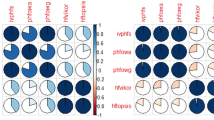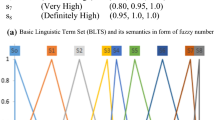Abstract
With growing hesitation in human perception, hesitant fuzzy set, an important extension of fuzzy set, has gained much attention from the research community. The concept of HFS gives decision makers the ability to provide multiple preferences for the same instance. However, the chance of these preferences occurring is assumed to be equal, which is unreasonable in practice. To circumvent this issue, probabilistic hesitant fuzzy set (PHFS) is adopted in this work, which is an extension of hesitant fuzzy set with associated probability values. Based on the literature review on PHFS, it is evident that (i) occurrence probability of each element was not methodically calculated; (ii) hesitation was not properly captured during criteria weight calculation; (iii) interrelationship among criteria was not captured during aggregation; and (iv) broad/rational ranking of alternatives with compromise solution was lacking. Motivated by these challenges and to alleviate the same, a systematic procedure is proposed in this paper to estimate these probabilities. Additionally, in this procedure, decision makers’ preferences are aggregated using the newly proposed probabilistic hesitant fuzzy generalized Maclaurin symmetric mean operator and criteria weights are calculated using the proposed statistical variance method in the context of PHFS. A new ranking method is also proposed that extends a well-known VIKOR method to the PHFS context. Further, the practical use of the proposed decision framework is demonstrated by two examples viz., selecting a suitable coordinator for a research and development project and selection of a doctoral candidate for the supervisor position. Finally, the strength and weakness of the proposed decision framework are realized by comparing it with state-of-the-art methods.






Similar content being viewed by others
References
Torra V (2010) Hesitant fuzzy sets. Int J Intell Syst 25(2):529–539
Rodríguez RM, Martínez L, Torra V, Xu ZS, Herrera F (2014) Hesitant fuzzy sets: state of the art and future directions. Int J Intell Syst 29(2):495–524
Xia M, Xu Z (2011) Hesitant fuzzy information aggregation in decision making. Int J Approx Reason 52(3):395–407
Wang C, Li Q, Zhou X, Yang T (2014) Hesitant triangular fuzzy information aggregation operators based on bonferroni means and their application to multiple attribute decision making. Sci World J 2014:1–16
Rashid T, Husnine SM (2014) Multicriteria group decision making by using trapezoidal valued hesitant fuzzy sets. Sci World J 2014:1–16
Ding Z, Wu Y (2016) An improved interval-valued hesitant fuzzy multi-criteria group decision-making method and applications. Math Comput Appl 21(2):22
Hu J, Xiao K, Chen X, Liu Y (2015) Interval type-2 hesitant fuzzy set and its application in multi-criteria decision making. Comput Ind Eng 87:91–103
Zhang Z (2013) Interval-valued intuitionistic hesitant fuzzy aggregation operators and their application in group decision-making. J Appl Math 2013:1–14
Zhu B, Xu Z, Xia M (2012) Dual hesitant fuzzy sets. J Appl Math 2012:1–16
Xu Z, Zhou W (2016) Consensus building with a group of decision makers under the hesitant probabilistic fuzzy environment. Fuzzy Optim Decis Mak 16(4):1–23
Hao Z, Xu Z, Zhao H, Su Z (2017) Probabilistic dual hesitant fuzzy set and its application in risk evaluation. Knowl Based Syst 127:16–28
Garg H, Kaur G (2020) A robust correlation coefficient for probabilistic dual hesitant fuzzy sets and its applications. Neural Comput Appl 32:8847–8866
Li J, Wang JQ (2019) Multi-criteria decision-making with probabilistic hesitant fuzzy information based on expected multiplicative consistency. Neural Comput Appl 31(12):8897–8915
Li J, Wang Z (2019) Multi-attribute decision making based on prioritized operators under probabilistic hesitant fuzzy environments. Soft Comput 23:3853–3868
Ali M, Shahzaib K, Saleem A, Fazal A (2020) Applications of probabilistic hesitant fuzzy rough set in decision support system. Soft Comput 24:16759–16778
Li J, Niu LL, Chen Q, Wu G (2020) A consensus-based approach for multi-criteria decision making with probabilistic hesitant fuzzy information. Soft Comput 24:15577–15594
Lin M, Zhan Q, Xu Z (2020) Decision making with probabilistic hesitant fuzzy information based on multiplicative consistency. Int J Intell Syst. https://doi.org/10.1002/int.22240
Garg H, Kaur G (2020) Quantifying gesture information in brain hemorrhage patients using probabilistic dual hesitant fuzzy sets with unknown probability information. Comput Ind Eng 140:106211. https://doi.org/10.1016/j.cie.2019.106211
Jiang F, Ma Q (2017) Multi-attribute group decision making under probabilistic hesitant fuzzy environment with application to evaluate the transformation efficiency. Appl Intell. https://doi.org/10.1007/s10489-017-1041-x
Yue L, Sun M, Shao Z (2013) The probabilistic hesitant fuzzy weighted average operators and their application in strategic decision making. J Inf Comput Sci 10:3841–3848
Zhou W, Xu ZS (2017) Probability calculation and element optimization of probabilistic hesitant fuzzy preference relations based on expected consistency. IEEE Trans Fuzzy Syst 67(6):1367–1378
Qin J, Liu X, Pedrycz W (2015) Hesitant fuzzy Maclaurin symmetric mean operators and its application to multiple-attribute decision making. Int J Fuzzy Syst 17:509–520
Wang JQ, Yang Y, Li L (2018) Multi-criteria decision-making method based on single-valued neutrosophic linguistic Maclaurin symmetric mean operators. Neural Comput Appl 30:1529–1547
Liao H, Xu Z (2018) Consistency of the fused intuitionistic fuzzy preference relation in group intuitionistic fuzzy analytic hierarchy process. Appl Soft Comput 35:812–826
Saaty TL (2008) Relative measurement and its generalization in decision making: why pairwise comparisons are central in mathematics for the measurement of intangible factors–the analytic hierarchy/network process. Rev R Acad Exact Phys Nat Sci Ser A: Math (RACSAM) 102(2):251–318. https://doi.org/10.1007/bf03191825. Retrieved 22 Dec 2008
Hafezalkotob A, Hafezalkotob A (2016) Fuzzy entropy-weighted MULTIMOORA method for materials selection. J Intell Fuzzy Syst 31(3):1211–1226
Liao H, Xu Z (2014) Priorities of intuitionistic fuzzy preference relation based on multiplicative consistency. IEEE Trans Fuzzy Syst 22(6):1669–1681
Liu S, Chan FTS, Ran W (2016) Decision making for the selection of cloud vendor: an improved approach under group decision-making with integrated weights and objective/subjective attributes. Expert Syst Appl 55:37–47
Kao C (2010) Weight determination for consistently ranking alternatives in multiple criteria decision analysis. Appl Math Model 34(7):1779–1787
Opricovic S, Tzeng GH (2004) Compromise solution by MCDM methods: a comparative analysis of VIKOR and TOPSIS. Eur J Oper Res 156(2):445–455
Cook M (2016) Personnel selection: adding value through people: a changing picture, 6th edn. Wiley, New York, p 368
Liao H, Xu Z (2013) A VIKOR-based method for hesitant fuzzy multi-criteria decision making. Fuzzy Optim Decis Mak 12(4):373–392
Xu Z, Zhang X (2013) Hesitant fuzzy multi-attribute decision making based on TOPSIS with incomplete weight information. Knowl Based Syst 52:53–64
Spearman C (1904) The proof and measurement of association between two things. Am J Psychol 15(1):72–101
Lima FR, Osiro L, Carpinetti LCR (2014) A comparison between Fuzzy AHP and Fuzzy TOPSIS methods to supplier selection. Appl Soft Comput J 21:194–209
Saaty TL, Ozdemir MS (2003) Why the magic number seven plus or minus two. Math Comput Model 38(3):233–244
Riaz M, Hashmi MR (2019) Linear Diophantine fuzzy set and its applications towards multi-attribute decision-making problems. J Intell Fuzzy Syst 37:5417–5439
Riaz M, Hashmi MR, Kalsoom H, Pamucar D, Chu YM (2020) Linear diophantine fuzzy soft rough sets for the selection of sustainable material handling equipment. Symmetry (Basel). https://doi.org/10.3390/SYM12081215
Riaz M, Tehrim ST (2020) A robust extension of VIKOR method for bipolar fuzzy sets using connection numbers of SPA theory based metric spaces. Artif Intel Rev. https://doi.org/10.1007/s10462-020-09859-w
Naeem K, Riaz M, Peng X, Afzal D (2019) Pythagorean fuzzy soft MCGDM methods based on TOPSIS, VIKOR and aggregation operators. J Intell Fuzzy Syst 37:6937–6957
Riaz M, Razzaq A, Kalsoom H, Pamučar D, Farid HMA, Chu YM (2020) q-Rung orthopair fuzzy geometric aggregation operators based on generalized and group-generalized parameters with application to water loss management. Symmetry (Basel). https://doi.org/10.3390/SYM12081236
Funding
The work was funded by the University Grants Commission India from Rajiv Gandhi National Fellowship under Grant No. F./2015-17/RGNF-2015-17-TAM-83 and the Department of Science & Technology Ministry of Science & Technology India from FIST program under Grant No. SR/FST/ETI-349/2013.
Author information
Authors and Affiliations
Corresponding author
Ethics declarations
Conflict of interest
All authors declare that they have no conflict of interest.
Ethical approval
This article does not contain any studies with human participants or animals performed by any of the authors.
Additional information
Publisher's Note
Springer Nature remains neutral with regard to jurisdictional claims in published maps and institutional affiliations.
Rights and permissions
About this article
Cite this article
Krishankumar, R., Ravichandran, K.S., Liu, P. et al. A decision framework under probabilistic hesitant fuzzy environment with probability estimation for multi-criteria decision making. Neural Comput & Applic 33, 8417–8433 (2021). https://doi.org/10.1007/s00521-020-05595-y
Received:
Accepted:
Published:
Issue Date:
DOI: https://doi.org/10.1007/s00521-020-05595-y




